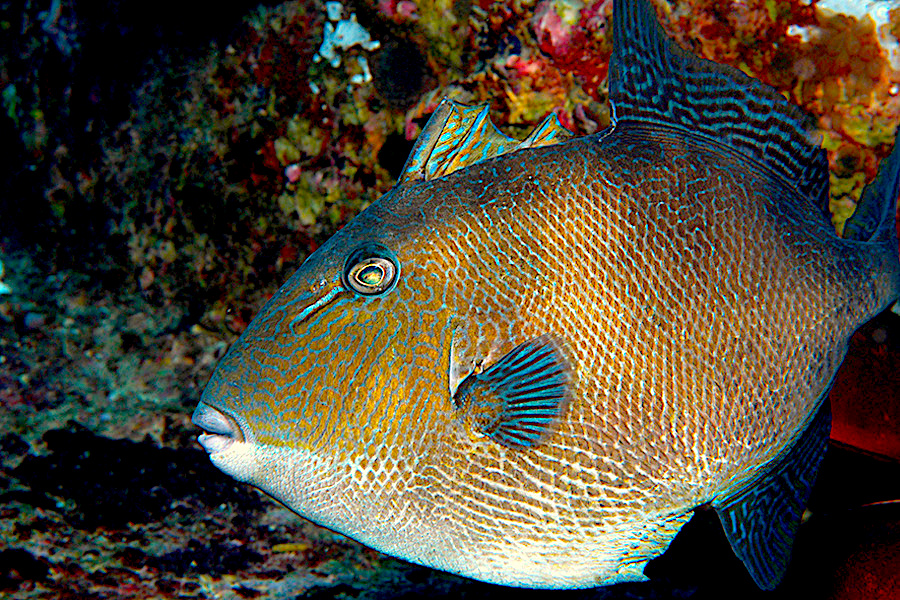How Diverse Are Temperate Reef Fishes on the Southeast Coast?

Over a three-year period, scientists observed 138 species of fish.
Triggerfish are thick out of North Carolina’s Oregon Inlet right now. The waters off the northern Outer Banks are prime fishing grounds, with each rock and crevice a potential honey hole for a number of bottom-dwelling species.
But which ones, specifically, could anglers expect to find?
Research Need
Temperate waters off the coast of North Carolina support a diverse reef-fish community. Saltwater fishing is wildly popular due to the accessibility of thriving reefs and wrecks in nearshore waters.
But unlike coral reef fishes in tropical environments, scientists have not studied temperate reefs to great extent. Fishery managers need data to document gradual changes in reef fish communities over time and to properly manage them for long-term viability.
What did they study?
Scientists wanted to know more about broad patterns and numbers of fish species inhabiting temperate reefs of the U.S. Southeast Atlantic. Using a fish trap mounted with a video camera, they collected underwater videos and fish samples at depths from 15 to 115 meters (49.2 to 377.3 feet) from Cape Hatteras, North Carolina, to St. Lucie Inlet, Florida.
Sampling occurred from spring through fall of each year. Scientists reviewed the videos to determine which fish species and families were most and least often observed on naturally occurring hardbottom reefs throughout the region. They then compared those observations to the number of species collected from fish trap sampling. Finally, the scientists examined how these observations changed with space, time, environmental conditions, and habitats.
What did they find?
From 2015 to 2017, scientists sampled 4,130 stations. Overall, they observed 138 species of fish.
Just over half of all species observed were seen on less than 1% of videos, and 23 species appeared just once in a single video. Video most often captured gray triggerfish (45.6%), tomtate (42.7%), red porgy (39.4%), almaco jack (36.6%), sand perch (35.8%), vermilion snapper (34.9%), and black sea bass (32.2%).
Some species were observed much more frequently in North and South Carolina compared to Georgia and Florida, including black sea bass, bandtail puffer, white grunt, scamp, and gag.
Generally, fishes occurred at consistent rates across the three study years. The biggest decline occurred with black sea bass, from 38.3% in 2015 to 29.0% in 2016. The largest increase occurred with red snapper, from 24.7% in 2016 to 34.3% in 2017.
Models suggested that the number of different fish species represented on a reef was highest at sites characterized by moderate depths, a high proportion of hardbottom, high elevation and slope of the hardbottom, and warm water.
So What?
Fishery managers can use these research results to predict areas of highest reef fish biodiversity at large (regional) and small (“microhabitat”) scales to improve marine-protected area design, delineate essential fish habitats, and refine ecosystem models.
Reading
Bacheler, N.M., Schobernd, Z.H., Gregalis, K.C., Schobernd, C.M., Teer, B.Z., Gillum, Z., Glasgow, D.M., McNeill, N., Burton, M., and Roldan Muñoz. 2019. “Patterns in fish biodiversity associated with temperate reefs on the southeastern US continental shelf.” Marine Biodiversity. 49:2411–2428.
NOAA’s National Marine Fisheries Service funded this study.
Summary compiled by Sara Mirabilio
Lead photo: gray triggerfish, courtesy of NOAA
The text from Hook, Line & Science is available to reprint and republish, but only in its entirety and with this attribution: Hook, Line & Science, courtesy of Scott Baker and Sara Mirabilio, North Carolina Sea Grant. HookLineScience.com
- Categories:



